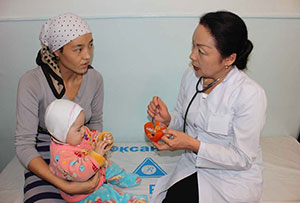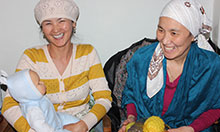
This module is intended to prepare facilitators/trainers with technical knowledge and skills to train doctors and nurses about adolescent and women’s nutrition and anemia throughout the life cycle. They will strengthen their knowledge and skills for counseling pregnant women during six antenatal care visits and three postnatal visits to help women learn to care for their own nutritional needs during pregnancy and lactation. They will be better able to counsel patients at the health clinics on the appropriate course of action when faced with issues related to anemia in infants and young children, pregnant and non-pregnant women of reproductive age, and the elderly.
Purpose
The purpose of this module is to explore issues regarding adolescent and women’s nutrition: nutritional status, causes of malnutrition, the effects of malnutrition on the intergenerational life cycle, the consequences of inadequate weight gain and micronutrient deficiencies, and the interventions to improve women’s nutrition. The module will also introduce participants to the clinical guidelines for screening, diagnosis, prevention, and treatment of anemia in children, adults, and pregnant women in primary health care settings.
Course Objectives: Knowledge and Skills
By the end of the training, the participants will have acquired the following knowledge and skills:
Knowledge
Participants will be able to—
- recognize key factors that contribute to a well-nourished adolescent or woman
- describe the causes that contribute to a malnourished adolescent/woman
- share in-country data on adolescent and women’s nutrition
- list the consequences of poor nutrition for adolescents/women and their babies
- describe the life cycle and actions that are needed to have a well-nourished infant, young child, and pre-teen
- explain the general dietary recommendations and identify available foods which provide key nutrients for families
- list recommended nutrition practices for adolescent girls
- list the additional nutrient requirements during pregnancy
- list recommended nutrition practices for pregnant women
- name the additional nutrient requirements during lactation
- list the recommended nutrition practices for mothers during lactation
- discuss why birth spacing is important to woman’s nutrition
- name the recommended time for spacing children and the criteria for the Lactation Amenorrhea Method (LAM)
- list the main causes of anemia and the interventions that have been shown to reduce anemia
- prevent, screen, and treat anemia in children, non-pregnant women of reproductive age, pregnant women, and the elderly
- name key practices provided to those taking oral Iron-Folic Acid (IFA) supplementation
- name key practices when counseling for anemia.
Skills
- Listening and learning skills
- Building confidence and giving support skills
- 3-step counseling (assess, analyze, act)
To view the full document, please download the full report above.
